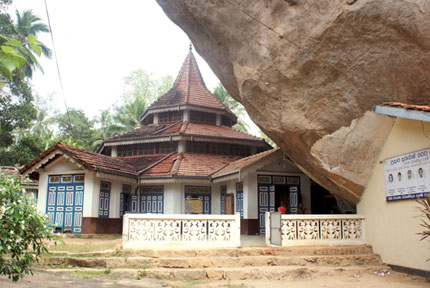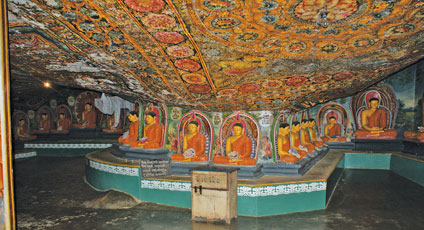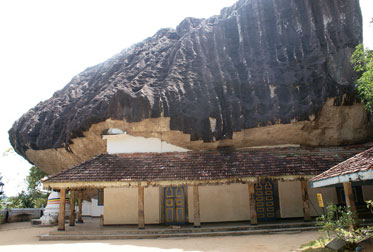|
Varana Temple:
A blend of serene beauty and nature's wonders
By Shanika SRIYANANDA
Can anyone explain how nature creates its wonders? It sounds a tough
task as nature has its own ways of forming unique things. This is more
evident when one steps into the rock temple of Varana, where serene
beauty and nature's wonders blend together.
 The
giant rock – the Idam gala - at a height of 100 feet, spans over one
acre, and is the location of the first cave, where Bhikkhus meditated
centuries ago. Now it has been converted into the Ven. Kossinne Sri
Pannananda Memorial Hall. The water in the small well in front of the
cave entrance with ancient wooden carvings is not hot, even though the
rock is baking under the scorching sun. The
giant rock – the Idam gala - at a height of 100 feet, spans over one
acre, and is the location of the first cave, where Bhikkhus meditated
centuries ago. Now it has been converted into the Ven. Kossinne Sri
Pannananda Memorial Hall. The water in the small well in front of the
cave entrance with ancient wooden carvings is not hot, even though the
rock is baking under the scorching sun.
It was on a glorious morning that we went to enjoy the serene beauty
of the Varana rock temple, off Thihariya in Gampaha.
The special feature of the temple, which is on a hillock, is its
unspoilt beauty, and its historic look which still remains.
A bell rang and a group of small samaneras in saffron robes rushed to
the well with their plastic bottles to be filled with water. Another
group, still in their 'mischievous' age, raced along the steps of the
adjoining old, white building which contains the library and Dhathu
mandiraya (the place where the sacred relics are housed). The small boys
who were waiting to enter bhikkhuhood ran behind them to help find some
Dhamma books. There are 23 student Bhikkhus at the Varana Mangalathiriya
Pirivena.
Freedom
”Hamuduruwane, Loku Hamuduruvo Innawada?”( “Ven. Thera, is the chief
incumbent there?”), I asked a Samanera Thera. “Ne, Danekata Wedala” (“He
has gone for an alms-giving”). After providing a brief answer, the young
Samanera ran away, adjusting his saffron robe. It seemed that he didn't
want to forgo the ‘freedom’ even for a few seconds.
 |
|
The beautiful artwork
and statues |
 |
|
The historic bell tower |
While we were exploring the beauty of the temple in its natural
landscape, the chief incumbent of the temple, Ven. Dompe Punnananda
Thera returned with several other bhikkhus from the alms-giving. He
welcomed us to the ‘meda pansala’, which is also built in a rock cave.
“Though this temple is called Varana Raja Maha Vihara, it is situated
in Mangalathiriya. There are over 32 caves in the vicinity which had
been used by Bhikkhus for meditation. The history of the cave temple
dates back to the third century BC, to the era of King
Devanampiyatissa”, Ven. Punnananda Thera said.
He said it was donated to Tissa Dhatta Thera, the brother of Majima
Thera, the best student of Arhant Mahinda Thera, who brought Buddhism to
Sri Lanka. Varana Temple is believed to be one of the ancient temples
built by King Devanampiyatissa.
There are many folk tales regarding the origin of the name Varana.
One such tale describes a huge forest patch full of ‘Va’ trees which
came to be known as Va+arana (forest patch). Another legend says that
the rocks in the area resemble elephants and the word ‘Waranaya’
(elephant) became Varana. According to yet another story, the name has
been derived from the word 'vulture' as a migrating vulture from the
Himalayas had used to rest on the huge rock, Idam gala.
 |
|
Ven. Dompe Punnananda
Thera |
According to epigraphical evidence, prehistoric settlements had
existed in the area and temples had been built surrounded by those
settlements. Ven. Punnananda Thera said the rocky caves were an ideal
hideout for King Walagamba as they were on a high elevation. The rocky
environs helped him re-organise his troops against the Chola invaders.
Later, when he regained power, he built a shrine in one of the caves.
The Nayaka Thera, referring to his awasa ge (living area) which is
also in a rock cave, said it provides a cooling atmosphere even on a
very hot day. It has drip ledges to drain rain water from the steep rock
surface. “These were designed during King Walagamba's era”, he said.
The next cave contained the shrine room with Jathaka stories drawn on
its walls. Ven. Punnananda Thera led us to the shrine, climbing over 100
steps, passing beautiful surroundings with a pond on the rocky surface
and green foliage. The small ‘dagoba’ (Pagoda) built in front of the
shrine is 800 yearsold.
Prehistoric equipment
“The area comprises about 20 acres. The Department of Archaeology
carried out some excavations a few years ago and found prehistoric
equipment used in the sixth century BC. There is evidence of prehistoric
settlements of Aryans in the area”, he said.
Ven. Punnananda Thera said the Archaeology Department, which took
away the four stone inscriptions found during the excavation, had not
yet revealed the information.
 |
|
The cave temple |
The cave vihara was another wonderful creation depicting the talents
of Sri Lankan artists of the Kandyan era. The Ven. Thera said during the
regime of King Parakramabahu VI who ruled in Kotte, he reclaimed the
Varana Temple and gifted a Buddha statue and a standing Vishnu statue to
the temple. He had also given more land to the temple.
Even after climbing hundreds of steps, one would not feel weary as
the cool climate is quite refreshing. The serene beauty and cooling
water soothe the mind and body. The tranquillity boosts mental and
spiritual harmony.
At the same time, the Nayaka Thera's words still echo in my ears:
“This temple is a very sacred place and one should not visit it for fun.
We are fully committed to protect the environment of Varana and no one
will be allowed to spoil its natural beauty”.
|

